Sociable Weaver Birds and Their Nest
Namibia’s unique desert ecosystem is home to many unusual species. One of the most fascinating is the little sparrow-like birds that build enormous structures for their family for generations to come. Sociable weaver birds survive and thrive in the desert because of their lifestyle and ingenious.
We first came across a haystack like structure on a tree in Kruger national park on Sunset Lake and did know what to make of it.
Driving across Namibia we saw tree after tree with what looked like huge haystacks on empty branches.
And haystacks on the telephone and electric poles.
It was really odd. How could a haystack this large get stuck so high? Maybe on bushy trees but how do they get stuck on poles?
We got curious so we started asking around and investigating the structures. To our surprise, we found that these structures are built by little sparrow-like birds that live in the arid and semi-arid regions of Namibia and South Africa. As we researched more, it got more and more interesting.
Sociable Weaver Nest’s Construction
Sociable weaver birds build huge nests on trees and telephone poles. They are easy to spot because they look like a pile of hay stuck on otherwise empty trees or on utility poles. From the top, the nest appears to have a heavy blanket of straws with no holes for entrance. However, hidden underneath are small holes. Each hole/opening is a passage into a chamber where multiple birds live together and eggs are incubated.
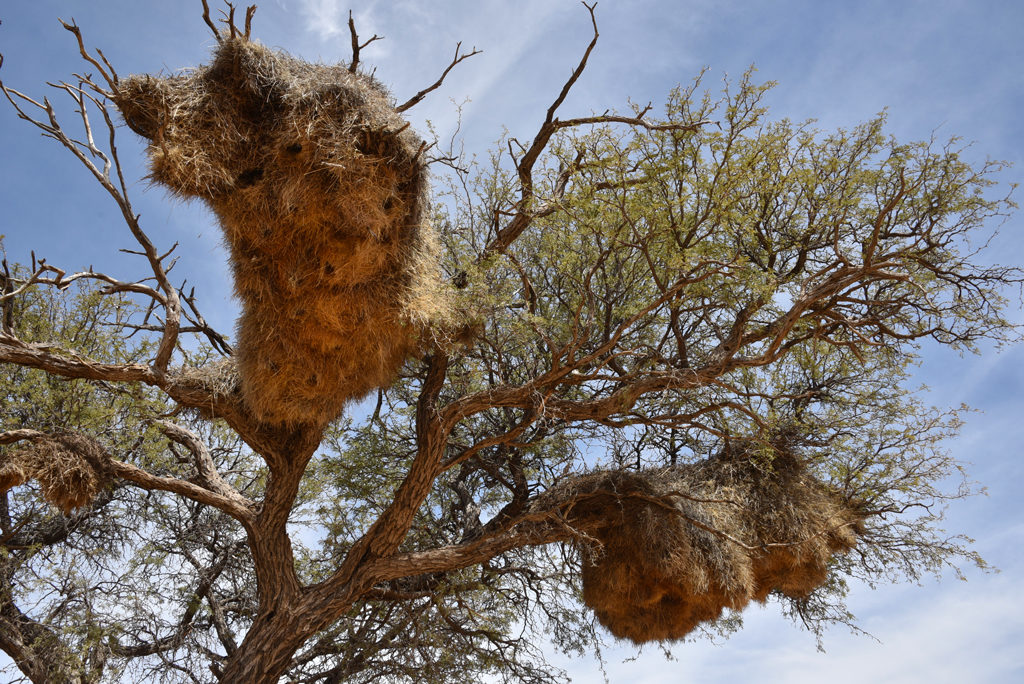
The sociable weaver birds have designed quite an engineering marvel. The large nest’s structure is supported strong wooden beams, filled with smaller branches and twigs to keep the structure together. The chambers are then created with independent entrances.
The sociable weaver nest keeps the extended family cool on hot summer days and warm on cold winter nights. The close proximity generates warmth, so they need very little food in to survive the cold winter months.
The family chamber is quite comfortable because it’s lined with twigs, cotton balls, and feathers.
Sociable weaver birds keep expanding the nests so they become enormous. When it rains the nest becomes wet, soggy and heavy. Sometimes the nest becomes so heavy that the entire tree collapses under its weight.
The sociable weaver birds are one of the rare birds that keep working on the nests all year long and over generations of birds. Most birds abandon their nest once the babies are grown up and start new nests every year. But, sociable weaver nests have been found to be 100 years old and thriving.
Here is a short video of a sociable weaver nest and the busy birds. Notice the cacophony of noises they made when we moved under the nest.
Sociable Weaver’s Lifestyle, Conservation, and Survival in the Desert
The sociable weaver birds live together as a family unit of parents, older kids, and babies.
These little birds know how to conserve resources in the arid desert and maximize their lifespan.
Sociable weavers live for nearly 10 years in the extreme conditions of the wild! Their secret to such a long life is a conservation-oriented lifestyle. They need very little food and they don’t start breeding until they are two years old. They drink almost no water and live mostly on seeds and little desert food.
For the first two years of their life, young sociable weaver birds do all the house chores like bringing food and twigs; building and cleaning the nest and caring for the babies. It’s only when they are secure and older, do they move out and start having babies. The kids never leave the nest, they move into another chamber in the same nest and continue supporting each other.
Once sociable weavers start having babies, they have lots of them and that’s pretty much all they do. So, the older kids are a crucial link in the long life of a sociable weaver nest.
The sociable weavers help their neighbors with food, childcare and house chores – as good human neighbors do in tight communities. They all survive and thrive together in healthy nests and healthy communities.
Predators and Threats for Sociable Weaver Birds
The sociable weaver’s nests do a great job of protecting the bird colony from big birds and predators. With the fully covered top area, the large birds can’t get to the nests and the babies. However, large birds commonly rest on top of the huge sociable weaver nests.
Their main predators include snakes and small mammals. Cobras can wipe out a whole nest filled with eggs in one big sweep. Some predators take over the sociable weaver nest and make it their own home. So, the sociable weaver birds like to build on telephone poles or trees with few branches. Without branches to crawl over its harder for predators to sneak into the nest.
The sociable weavers protect themselves by make deafening shill noises when danger approaches. They can also attack predators in large numbers to protect their nest.
The Eagles and big birds perched on the sociable weaver nest make noises with approaching predators and warn the sociable weaver birds inside the nest.
More About Sociable Weaver Birds
The nests can be easily spotted all long roads in arid and semi-arid parts of Namibia and South Africa.
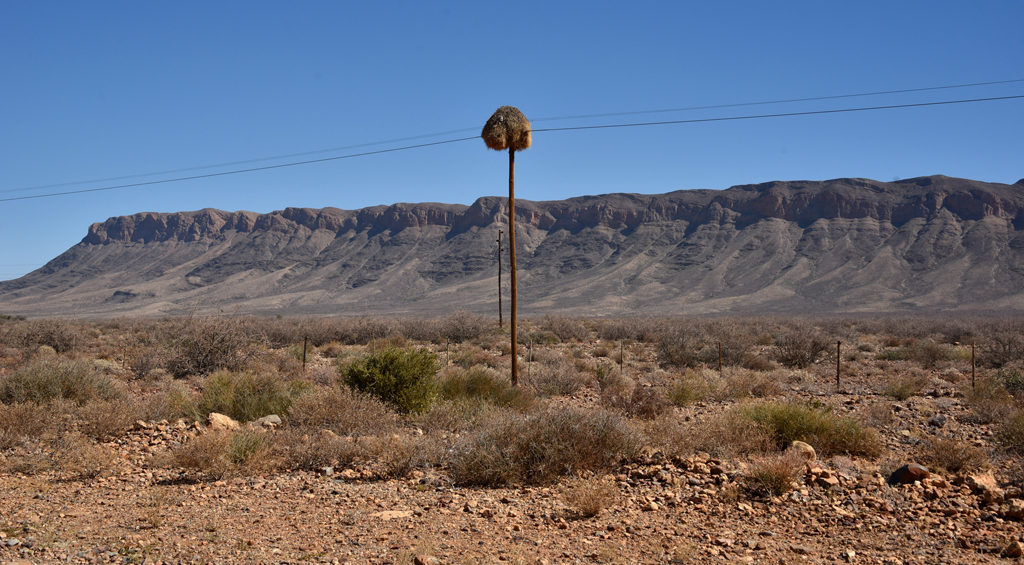
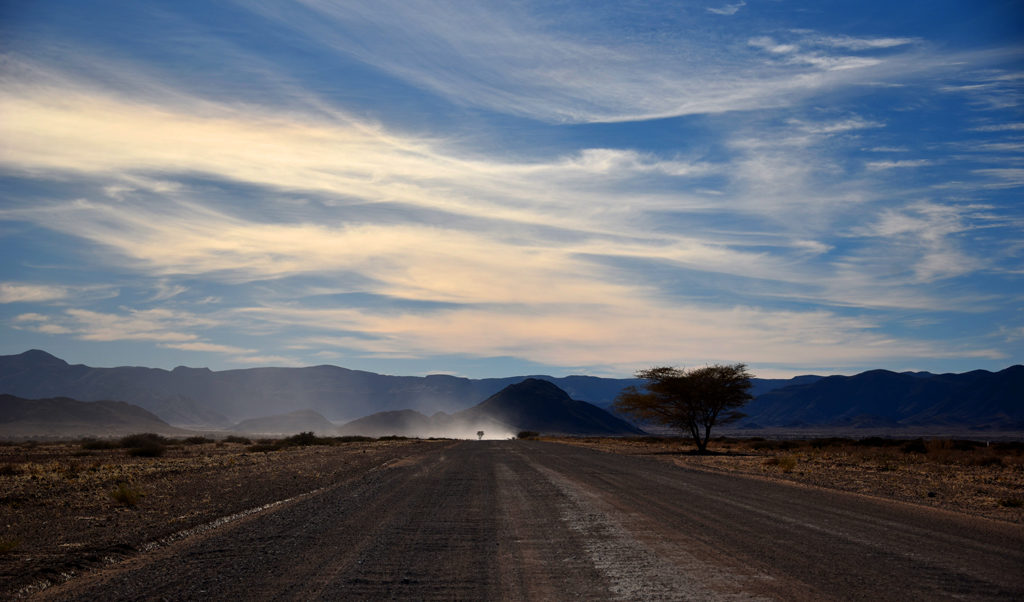
Red-billed Buffalo-Weaver
It turns out that the odd structures we saw in Kruger’s Sunset lake is in fact made by Red-billed Buffalo-Weaver.
Thanks, Robert of the African Pygmy Falcon and Sociable Weaver nests project for sharing the information.
Also, thanks Robert for sharing the information that sociable weavers are restricted to the Kalahari and Namib desert.
Weaver Bird
The weaverbirds can be found in many parts of Africa. We saw a large number of nests during our horseback safari in Victoria falls and on our drives in Namibia.
Related Links
- 14-Day Trip in Southern Africa
- 4-Days in Namibia
- Sociable weaver on wikipedia
- Africa Geographic article
- Sociable Weaver web-story
- Wildlife crossings in Banff
- Southern Africa wildlife photo gallery

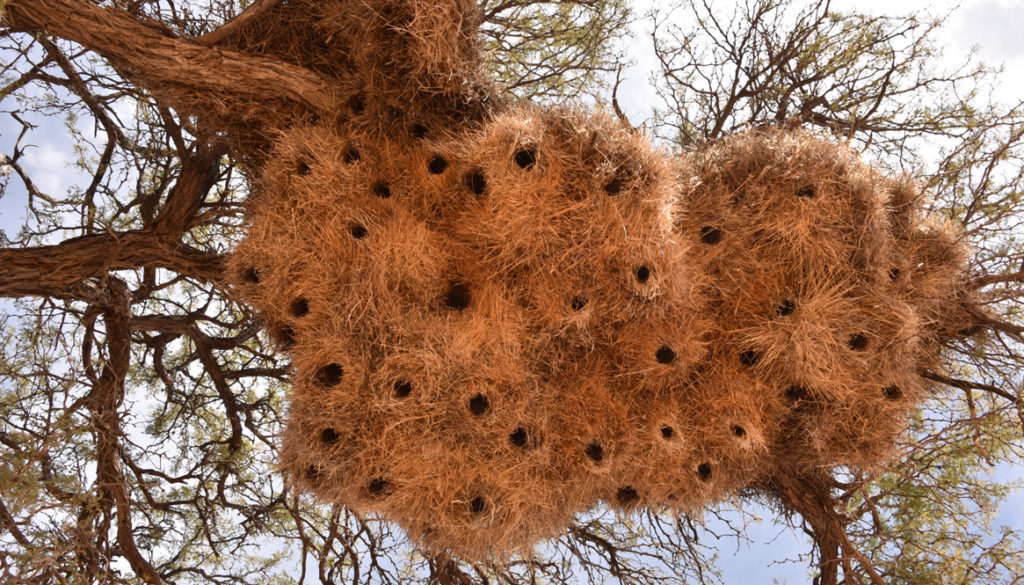
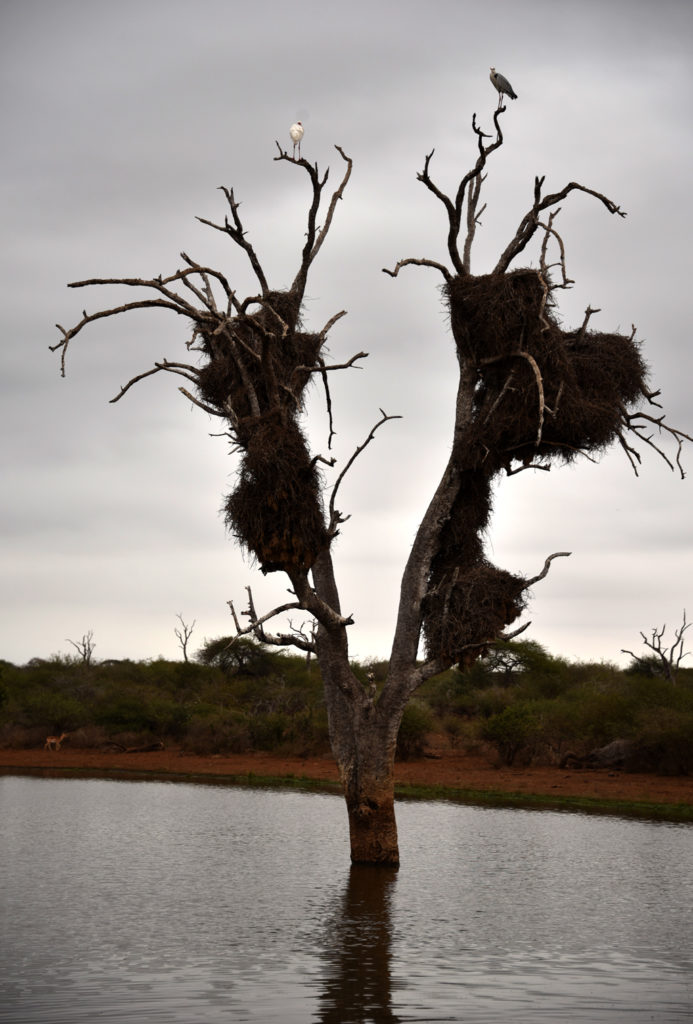
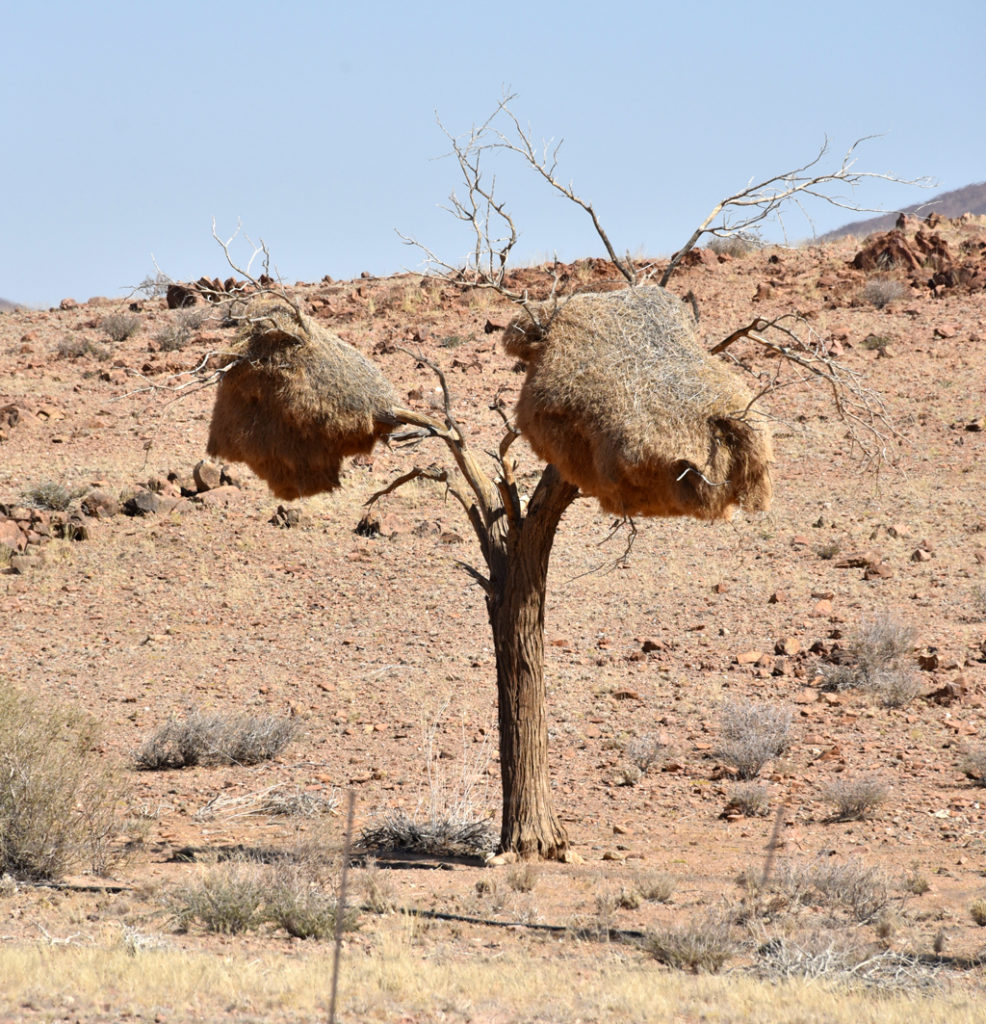
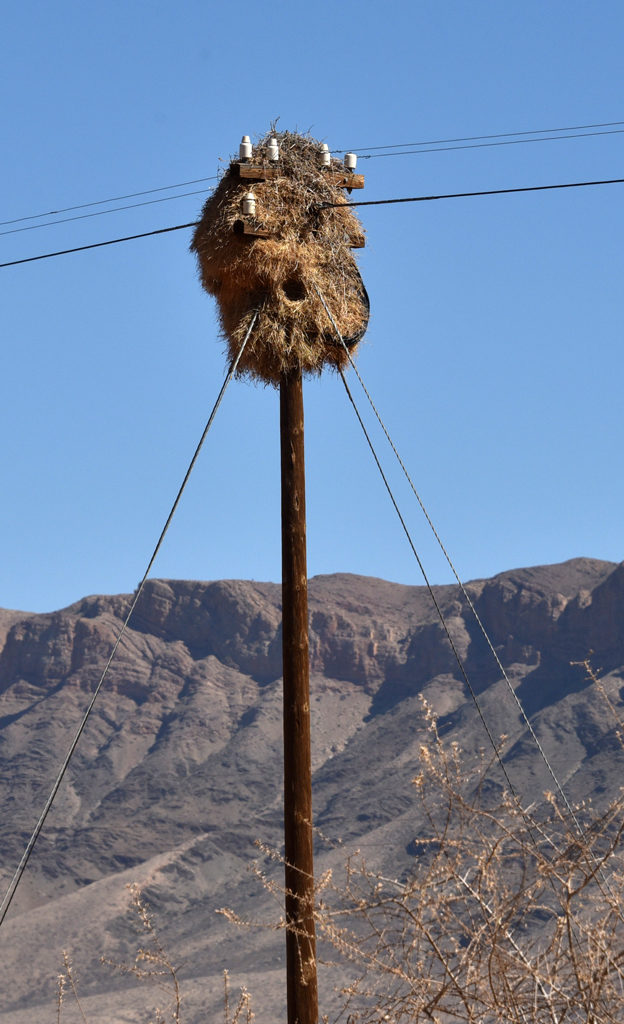
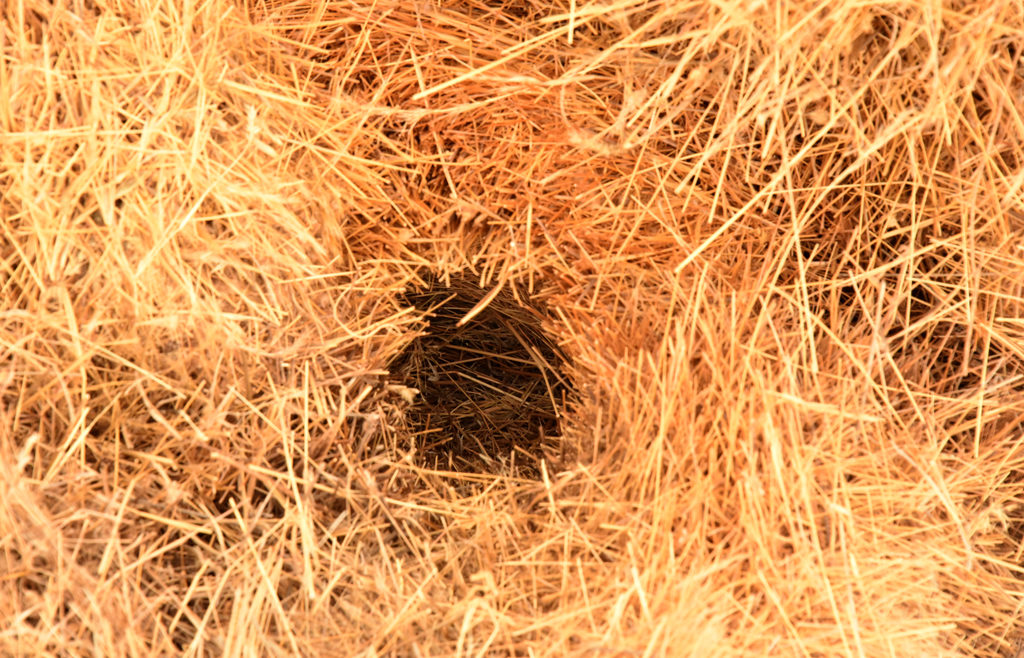
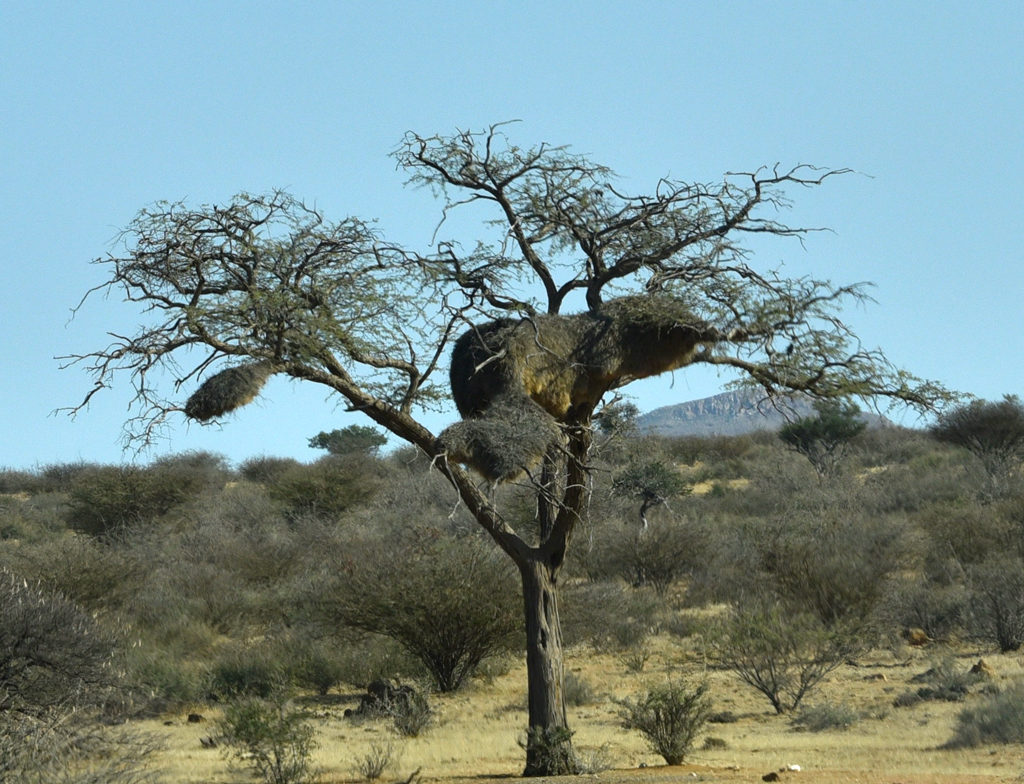
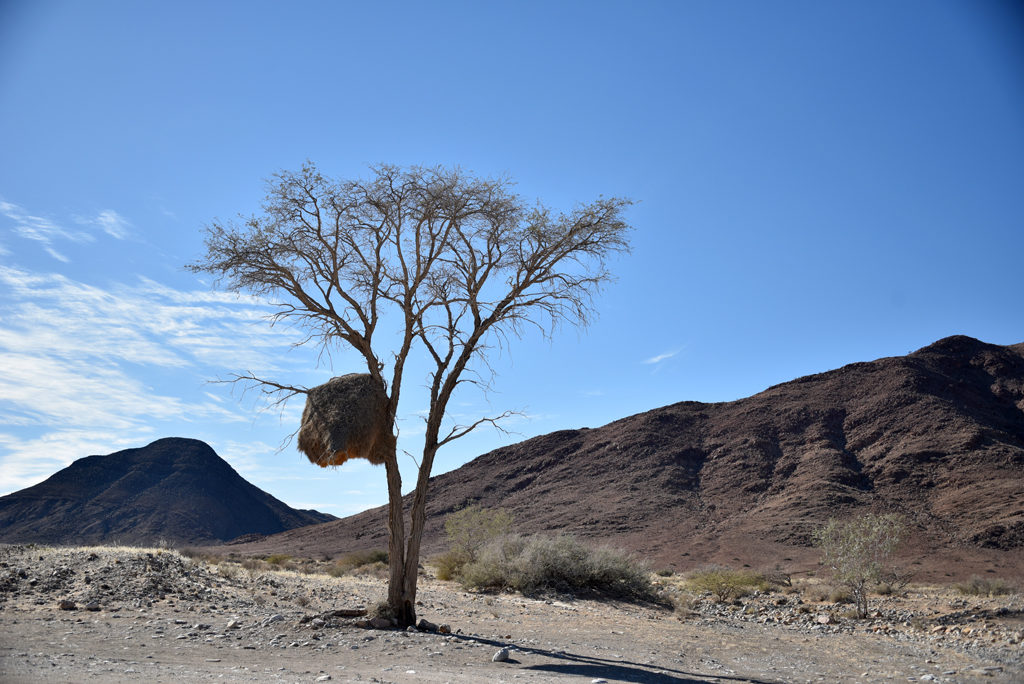
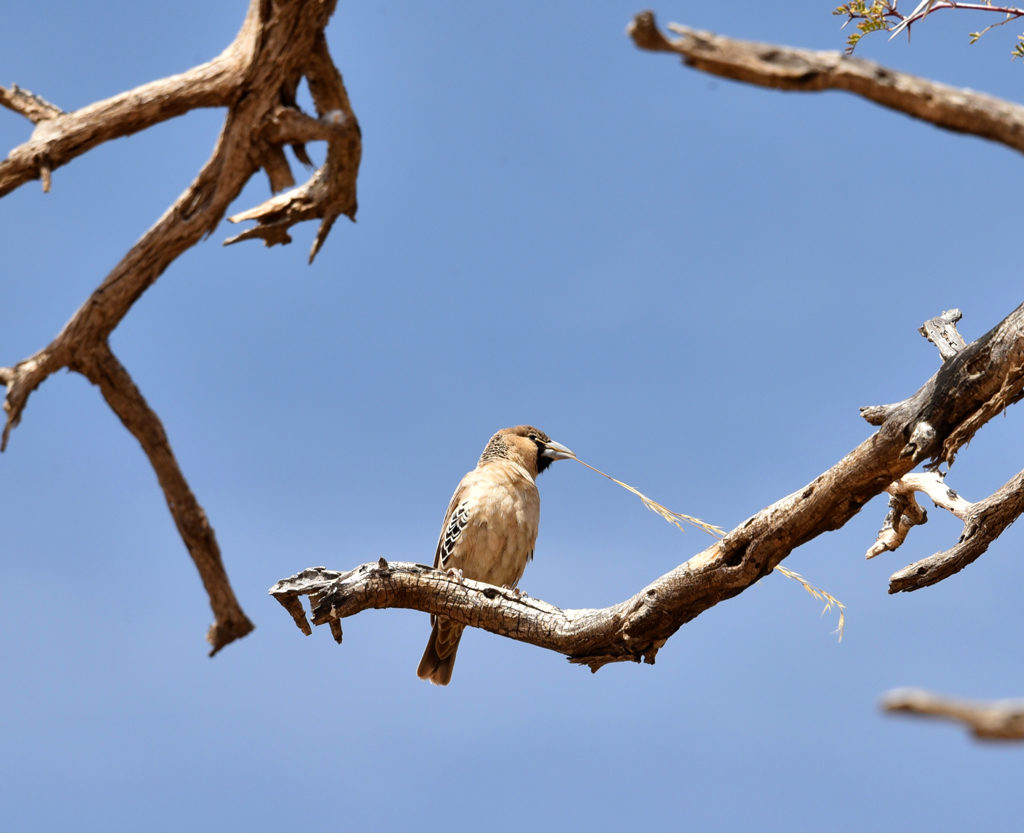
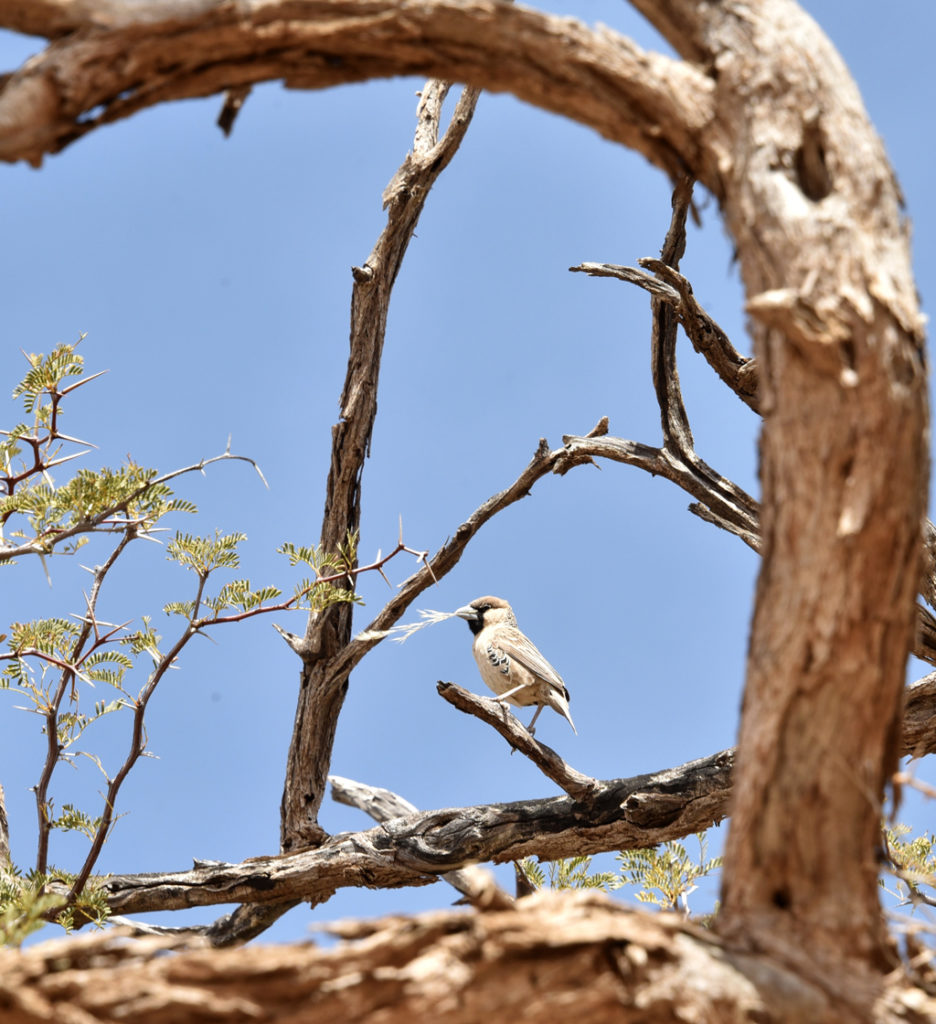
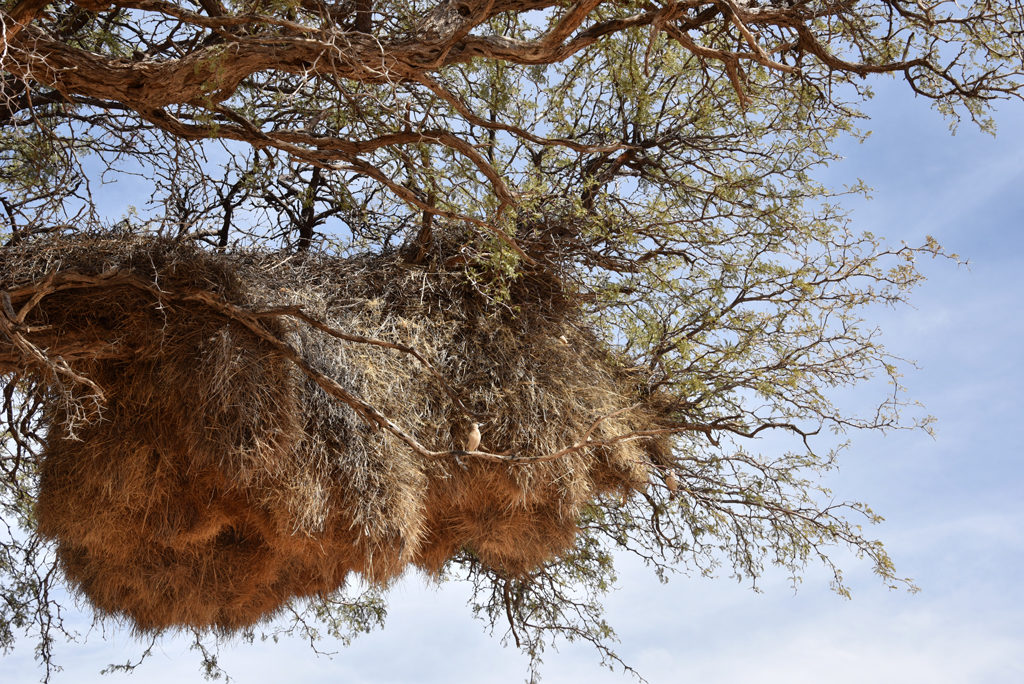
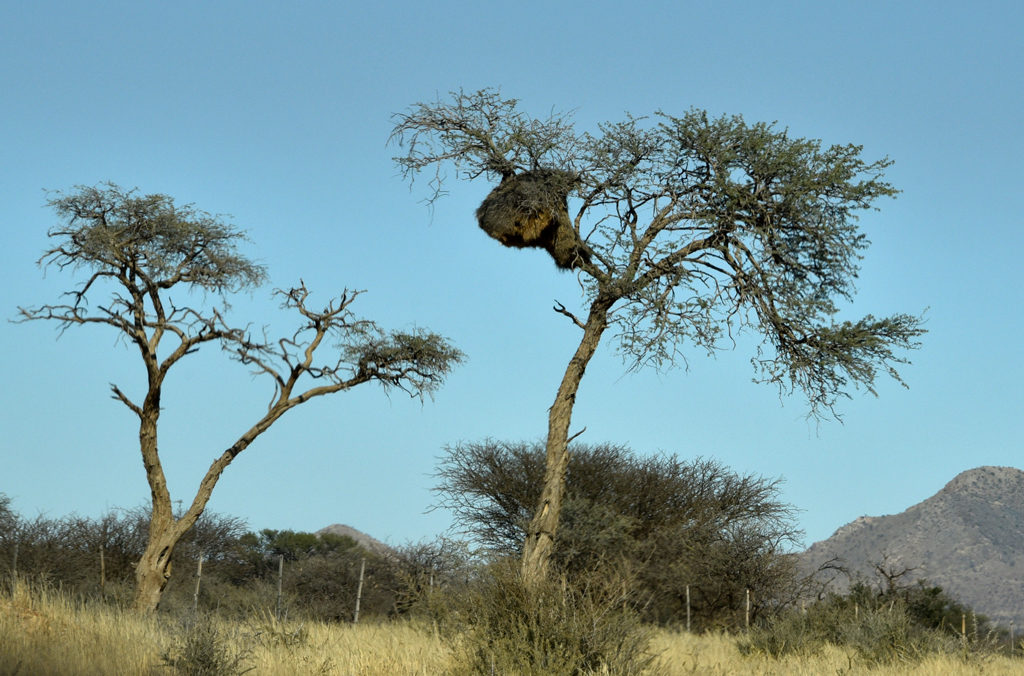
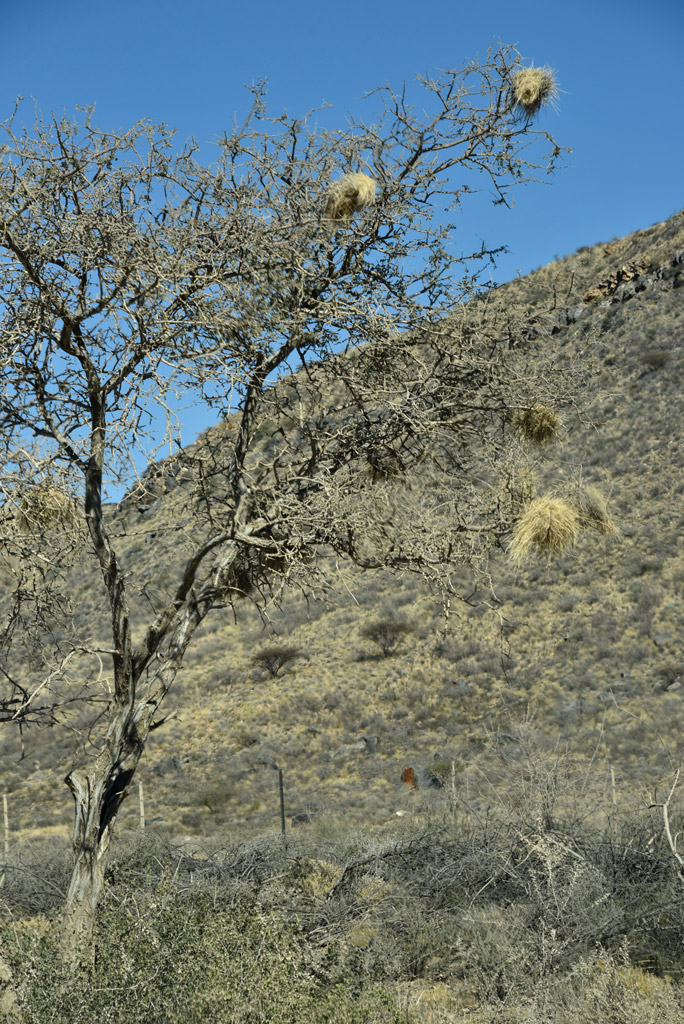
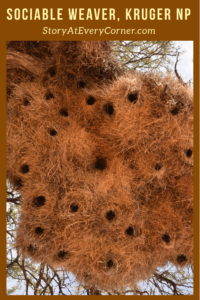
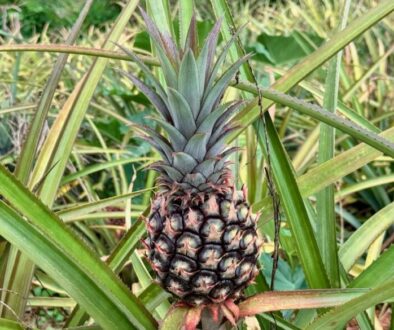



Jackie
September 1, 2018 @ 12:22 am
Visiting Namibia is on our travel bucket list. What an interesting thing to come across during your Namibia adventures. From afar, the nests look like beehives. It’s cool to hear how the social weavers survive with little water and they are adorable too.
Jyoti
September 1, 2018 @ 10:04 am
Hi Jackie, I would totally recommend Namibia and I hope you’ll visit. It was nothing like what I had expected. We went there to see the orange dunes in the Namib desert but we found there is so much more to return for – the wildlife, the okangawa delta, beaches, mountains, the villages and of course the desert. It’s safe, politically stable and upcoming economy.
Alissa
September 1, 2018 @ 8:49 am
Such a cool post – I had no idea!! I love that you took the time to investigate and explain these observations. Also it’s pretty amazing that the birds build nests on telephone poles! Thanks for educating me on sociable weavers 🙂
Jyoti
September 1, 2018 @ 10:07 am
Hi Alissa, thanks so much for recognizing the investigation. I’m always curious about the obscurest things 🙂
The sociable weaver nests are so intriguing because of their size but the birds and their lifestyle is much more interesting so unique from any fellow species. It’s amazing how evolution works in the face of adversity. Species that innovate, thrive.
Sara Essop
September 1, 2018 @ 9:42 am
I saw tons of these while driving through Namibia and wondered what they were. Eventually, our safari guide in Etosha told us. Thanks for sharing more details.
Jyoti
September 1, 2018 @ 10:15 am
I totally relate to how you would have felt 🙂
The first one we saw it felt peculiar. The next time it was odd. Then every few miles we’d see another one. I couldn’t resist turning on cellular data where there was almost no signal to check.
It was great to get up close and witness life in these sociable weaver nests upclose.
We were self driving. Did your guide share any nuggets of information I haven’t found?
Madhu
September 1, 2018 @ 10:53 am
These nest look so big and different I have never seen something like this before. Loved reading the post.
Jyoti
September 2, 2018 @ 4:13 pm
Hi Madhu, Thanks and I’m so glad you enjoyed reading about little sociable weavers! Its such an expected structure.
Julia Dent
September 1, 2018 @ 11:49 am
I have never seen nests like that before, but they look so cool! It’s so interesting that a bird so small could make such a big nest!
Jyoti
September 2, 2018 @ 4:10 pm
Hi Julia
You’re totally right! such tiny birds with long lives, amazing social intelligence, brilliant adaption and such massive nests! A testament to survival again all odds.
Mo
September 1, 2018 @ 3:54 pm
Fascinating! I can’t say I have ever been too much into birds, but reading your post was like watching a national geographic channel – somehow you are glued to learning about something you never knew 😉
The animal kingdom and its evolution never cease to amaze me!
Jyoti
September 2, 2018 @ 4:07 pm
Hi Mo, so well said. Its human nature for us to gravitate to the unexpected. Thanks so much for your compliment.
Alma
September 5, 2018 @ 12:48 am
I love these nests. The Kgalagadi has some fine examples.
Jyoti
September 8, 2018 @ 4:00 pm
Me too 🙂
Thanks for sharing a new word ‘Kgalagadi’. According to Wikipedia it means “Land of the thirst”, is a geographical area located in Southern Africa. I’m sure there are many weaver bird nests in the dry regions.